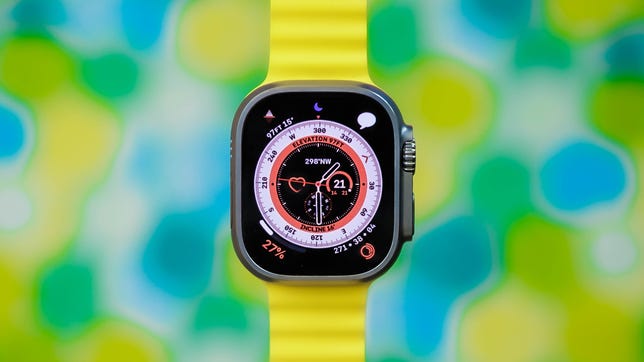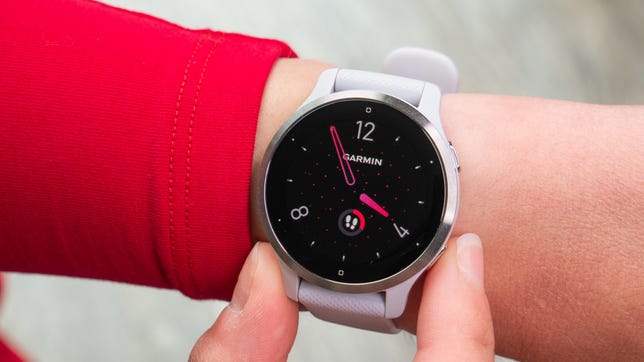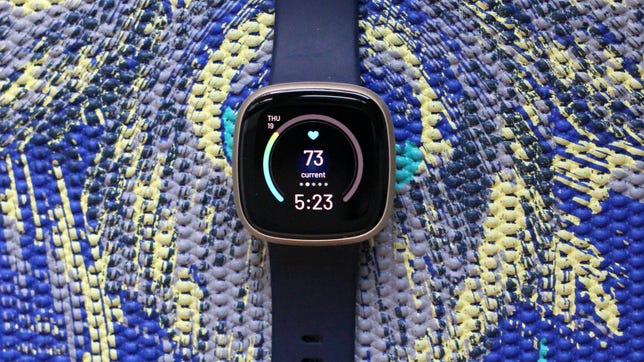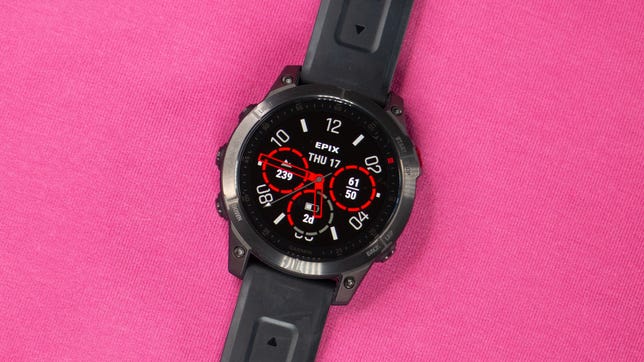Technologies
Best Smartwatch for 2023
Check out our favorite smartwatches for every wrist and budget.

There are plenty of worthwhile smartwatches out there, from the Apple Watch to Samsung’s Galaxy Watch and everything in between. Finding the right one depends on your budget and what you’re hoping to get out of a smartwatch. You’ll also want to consider which type of phone you have, since certain models only work with iPhones or Android devices.
But that only scratches the surface. Most smartwatches should include additional features such as heart-rate monitoring, activity tracking, sleep tracking, GPS tracking and the ability to show phone notifications on your wrist. Many of the best smartwatches also support contactless payments and others have LTE or cellular connectivity, so you really can leave your phone at home.
We’ve rounded up the top smartwatches you can buy in 2023 based on function, price and compatibility to help you decide which is the best smartwatch for you. This list is updated periodically with new reviews of the best smartwatch options. For more buying advice, check out our guide to how to buy a smartwatch.
Read more: Best Budget Smartwatches Under $100
James Martin/CNET
The Apple Watch Ultra is a souped-up Apple Watch Series 8, but comes with a tough titanium construction, larger 49mm case size and new Action button to quickly start workouts or launch apps. It has an incredibly bright screen, able to reach a maximum of 2,000 nits which makes it incredibly easy to see when adventuring in the great outdoors. It also has a built-in siren for safety and dual-band GPS for accurately tracking your route. LTE is also onboard so you can venture out without a phone and still stay connected.
While many of its key hardware and software features are aimed towards adventurers and athletes, it’s still a fantastic all-round smartwatch. The microphones help reduce wind noise during calls and you get all the same health and fitness tracking features found on other Apple Watches, including a blood oxygen sensor, electrocardiogram (ECG or EKG) app, fall detection and emergency SOS. The battery also lasts at least twice as long as all other Apple Watch models. But it’s only compatible with the iPhone, so if you have an Android phone, you’ll want to look at another option on this list.
James Martin/CNET
The Apple Watch Series 8 might not be as adventure-focused as the Apple Watch Ultra, but it still features a dust- and crack-resistant design, a blood oxygen and ECG sensor and comes in 41 and 45mm sizes. You can also choose a cellular or LTE model that lets you take calls and answer messages from your wrist without your phone, although that does cost extra.
It also has a new temperature sensor that can be used for applications like ovulation tracking. But battery life generally lasts 18 hours with typical use, less than many of its competitors.
Lexy Savvides/CNET
The Garmin name has long been synonymous with fitness tracking, but many of the company’s earlier watches haven’t exactly looked or felt that «smart.» The Venu 2 has a sleek, round design with a bright screen that’s easy to see in direct sunlight. It’s also compatible with Android and iOS, has great in-depth fitness features like comprehensive workout tracking, a body battery that tells you if you should push yourself to workout or take a rest day, plus women’s health tracking. It can also take blood oxygen levels and the battery will last several days with moderate use.
The downside is that it doesn’t have as many smart features as other watches on this list, including no LTE or cellular connectivity. If you want a speaker and mic onboard to talk to your voice assistant or answer quick calls on your wrist while your phone is in range, take a look at the newer $450 Garmin Venu 2 Plus. It only comes in one 43mm size but shares all the same features with the original Venu 2 and 2S.
Andrew Lanxon/CNET
Google’s first Pixel Watch wants to tackle the Apple Watch head-on. For the most part, it succeeds thanks to a sleek, curved design and a range of health sensors including an ECG app and blood oxygen tracking. It has a suite of fitness tracking features and analysis through the Fitbit app and accurate heart rate tracking.
Beware that the battery isn’t as strong as other options on this list and you will likely find yourself charging this watch every day, especially if you like to do outdoor GPS workouts and track your sleep. It’s also only available in one 41mm size.
Lexy Savvides/CNET
Samsung’s Galaxy Watch 5 and Watch 5 Pro are among the best Wear OS watches you can get right now. They have longer-lasting batteries than last year’s Galaxy Watch 4 models and plenty of great fitness tracking features. Google apps including YouTube Music, the Google Assistant and Google Maps are available, with many more apps accessible through the Play Store. Samsung is also bringing cycle tracking to the Galaxy Watch 5 and Watch 5 Pro by partnering with Natural Cycles.
You do, however, need a Galaxy phone to use the ECG, but all the other features work seamlessly with other Android phones. Both watches miss out on the classic physical rotating bezel, one of the signature features of Samsung’s Galaxy Watch and Gear watches from years past.
If you’ve never owned an Apple Watch, this is the one to get. The second-generation Apple Watch SE is a cheaper alternative to the Series 8 but has plenty of the same great features including crash detection, heart rate monitoring and water resistance. It misses out on health sensors like ECG, blood oxygen and temperature sensing like the Series 8, but the most notable difference between the two is that the SE doesn’t have an always-on display. But you might not miss it if you’ve never had this smartwatch feature.
Angela Lang/CNET
The Versa 3 is compatible with both iOS and Android phones and lets you choose between Alexa or Google Assistant as your go-to voice assistant. It doesn’t offer all the apps and smart features as some of its competitors, but it’s a well-rounded smartwatch with plenty of health and fitness features to keep you on track like onboard GPS and live heart rate zone notifications. It has the best sleep tracking feature on this list and even gives you health features including a breakout of your SpO2 and body temperature data overnight (Fitbit Premium users). There’s a newer version, the Fitbit Versa 4, but we haven’t fully reviewed that watch yet so stay tuned.
Lexy Savvides/CNET
The second-generation Garmin Epix features a tough titanium construction and a laundry list of features athletes want, including extensive mapping capabilities. It also has a bright AMOLED display which sets it apart from a multitude of other sports watches, including Garmin’s own Fenix line, that often use transflective displays. The Epix 2 also has great battery life considering its size and feature set, lasting almost a week under regular conditions.
But it doesn’t have LTE capabilities or an ECG app. Considering this is the most expensive watch on this list at $1,000, that might be a big drawback.
Lexy Savvides/CNET
Polar’s Grit X Pro is an outdoor watch for adventure seekers. The rugged design can withstand the elements as it’s water-resistant to 100 meters and has a sapphire glass watch face that’s scratch-resistant. With onboard maps, turn-by-turn navigation and overnight recovery tools, you can determine if you’re ready to take on that workout. This is much more a sports watch than a smartwatch, but it can still get notifications from your phone, control music playback and has 24/7 heart rate monitoring.
The touchscreen is less responsive than other watches on this list — it’s transflective rather than AMOLED — but you can get away with using button controls.
More fitness trackers and clocks
- 5 Years Ago, I Thought Apple Watch Was Very ‘Meh.’ Here’s Why I Changed My Mind
- Apple Watch SE vs. Apple Watch Series 7
- 13 Apple Watch Bands to Get on Amazon
- Best Apple Watch Series 7 Cases
- How to Buy a Smartwatch or Fitness Tracker
- Best Fitness Trackers for 2023
- Best Alarm Clock for 2023
- Best Alarm Clocks for Sunrise
- Best Home Exercise Equipment to Buy for 2023
- Best E-Bikes to Ride in 2023
- Best Peloton Alternatives: 5 Great Indoor Exercise Bikes That Cost Less
Technologies
Give the Gift of Great Sound With Sennheiser Headphones at a 60% Black Friday Discount
The Sennheiser Momentum 4 headphones are now down to a record low price of $179 this Black Friday.

Spending this Black Friday shopping for a holiday gift for an audiophile? With tons of items on sale, there are plenty to chose from. Sennheiser is behind some of the best wireless headphones you can buy, but its headphones can be prohibitively costly.
But for two days only, Woot is running a Black Friday deal that brings the Sennheiser Momentum 4 headphones down to $179 from the original $450 price. The Sennheiser Momentum 4 headphones are for audiophiles who want great quality and comfort. You have to be quick, as this deal ends on Nov. 30, or sooner if supplies run out.
Sennheiser Signature Sound gives you rich, balanced audio, and the companion Smart Control app lets you fine-tune the sound to your liking. Adaptive noise cancellation keeps outside distractions at bay, making these headphones great for work, commuting or just zoning out at home. The battery lasts up to 60 hours at moderate volume, and the voice-calling quality is solid, so you can rely on them for everyday use.
Hey, did you know? CNET Deals texts are free, easy and save you money.
If this style of headphones isn’t your cup of tea, then maybe a pair of the best wireless earbuds will be better suited to your needs. If you’re shopping on a budget, check out our roundups of the best gifts under $100, $50 and $25 to see more great gift-giving ideas.
HEADPHONE DEALS OF THE WEEK
-
$248 (save $152)
-
$170 (save $181)
-
$199 (save $150)
Why this deal matters
This deal surely won’t last. Sennheiser has made a name for itself as one of the best in the audio business, and that’s clear with the Momentum 4 wireless headphones. They offer adaptive noise cancellation, a Bluetooth connection and up to 60 hours of playback. When it comes to comfort and quality, it doesn’t get much better, especially with a discount like this.
Join Our Daily Deals Text Group!
Get hand-picked deals from CNET shopping experts straight to your phone.
By signing up, you confirm you are 16+ and agree to receive recurring marketing messages at the phone number provided. Consent is not a condition of purchase. Reply STOP to unsubscribe. Msg & data rates may apply. View our Privacy Policy and Terms of Use.
Technologies
Samsung’s Galaxy Watch 8 Is Now Just $250 in Multiple Black Friday Sales
The Samsung Galaxy Watch 8 is an even better value with this $100 discount.

The holiday season is here, and while your fitness goals might not be at the front of your mind right now, January is just around the corner. That means resolutions are upon us, so what better time than now to pick up a new smartwatch? You can get your hands on a new Samsung Galaxy Watch 8 while it’s available for a huge $100 off for Black Friday.
Amazon and Best Buy are both selling the Galaxy Watch 8 at the same $250 price. We can’t promise either deal will be around for long.
Samsung’s latest smartwatch packs serious hardware upgrades over it predecessor. It has a vibrant 46mm AMOLED display that shines up to 3,000 nits, along with 2GB of RAM, 64GB of storage, built-in GPS and advanced fitness tools, including sleep coaching and vascular load monitoring. It’s waterproof up to 50 meters and lasts up to 30 hours on a single charge.
CNET expert Vanessa Hand Orellana praised its refined design, detailed health insights and Gemini AI support, noting that it «has nearly every feature I could hope for.» Just remember, some tools work best when paired with the Samsung Galaxy phone.
SMARTWATCH DEALS OF THE WEEK
-
$339 (save $60)
-
$280 (save $70)
-
$300 (save $50)
-
$150 (save $100)
-
$49 (save $30)
Why this deal matters
The Samsung Galaxy Watch 8 packs serious upgrades for the price. With advanced fitness tools, sleep coaching and daily energy tracking, it’s one of the most feature‑rich smartwatches this year. The $250 price represents a new low for the model and includes a 90-day warranty. But with limited stock, it’s a deal worth grabbing quickly.
Join Our Daily Deals Text Group!
Get hand-picked deals from CNET shopping experts straight to your phone.
By signing up, you confirm you are 16+ and agree to receive recurring marketing messages at the phone number provided. Consent is not a condition of purchase. Reply STOP to unsubscribe. Msg & data rates may apply. View our Privacy Policy and Terms of Use.
Technologies
The Black Friday Gaming Deals Are Here. Shop Now and Save Big on PlayStation, Xbox and Alienware
-

 Technologies3 года ago
Technologies3 года agoTech Companies Need to Be Held Accountable for Security, Experts Say
-

 Technologies3 года ago
Technologies3 года agoBest Handheld Game Console in 2023
-

 Technologies3 года ago
Technologies3 года agoTighten Up Your VR Game With the Best Head Straps for Quest 2
-

 Technologies4 года ago
Technologies4 года agoBlack Friday 2021: The best deals on TVs, headphones, kitchenware, and more
-

 Technologies4 года ago
Technologies4 года agoVerum, Wickr and Threema: next generation secured messengers
-

 Technologies4 года ago
Technologies4 года agoGoogle to require vaccinations as Silicon Valley rethinks return-to-office policies
-

 Technologies4 года ago
Technologies4 года agoOlivia Harlan Dekker for Verum Messenger
-

 Technologies4 года ago
Technologies4 года agoiPhone 13 event: How to watch Apple’s big announcement tomorrow









